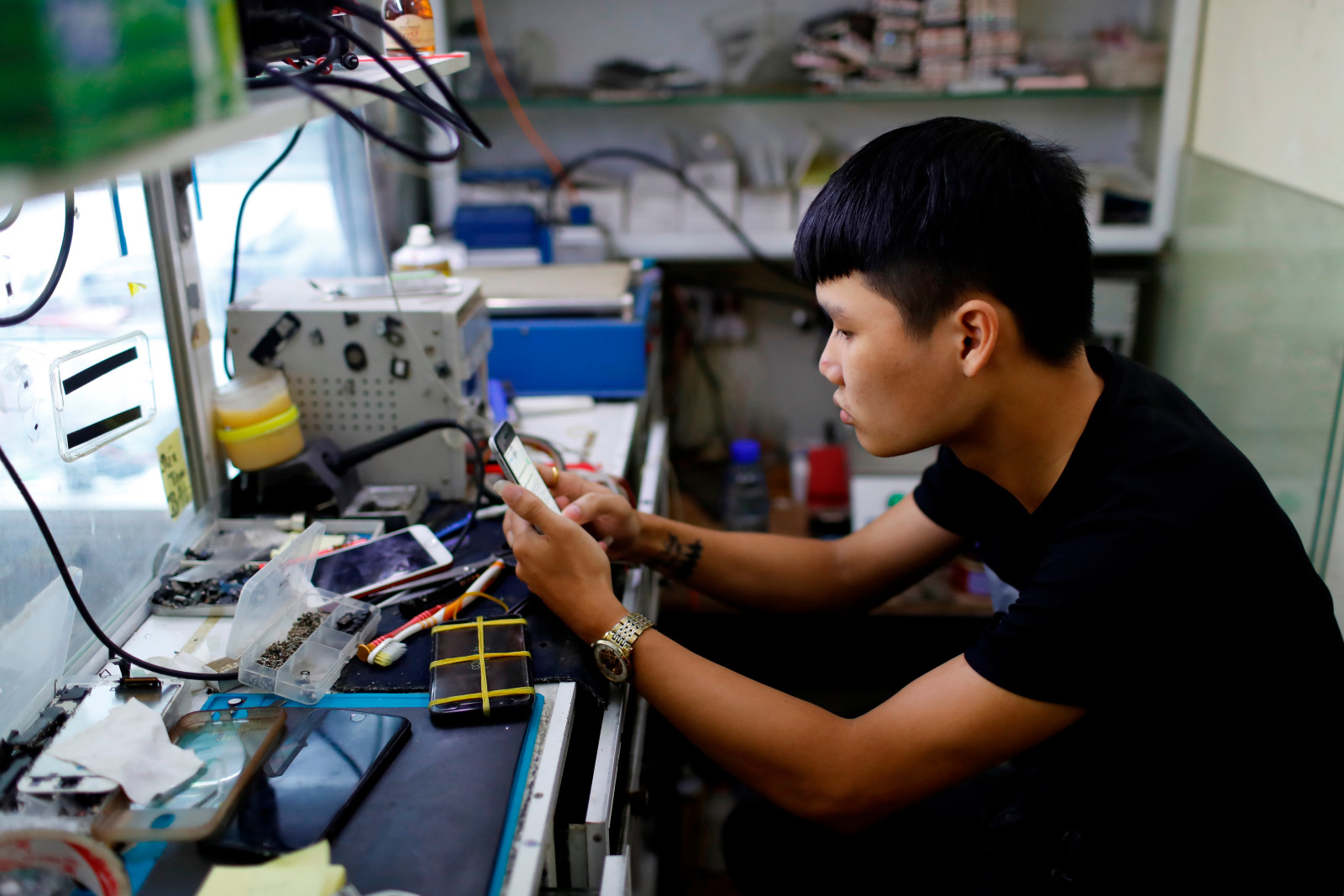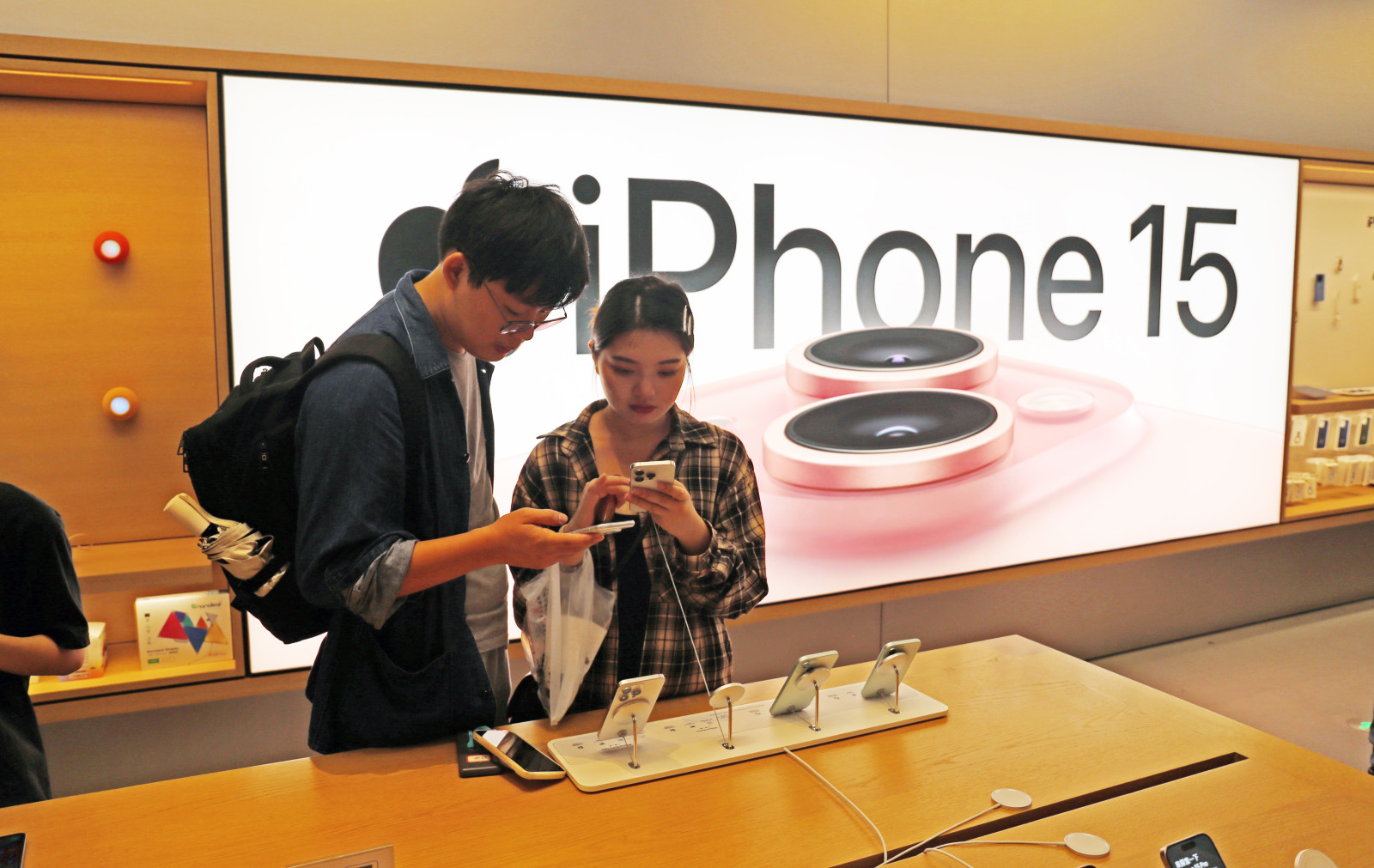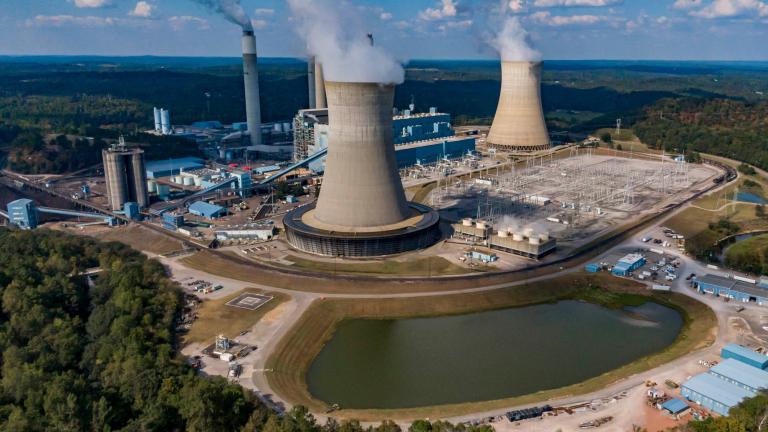Romain Godin prides himself on being able to fix a wide variety of consumer devices. But recently, what was once a basic repair job for his Portland, Oregon-based business Hyperion Computerworks — replacing a cracked iPhone screen — has become needlessly complicated.
In the past, Godin would have replaced the broken screen on the spot with a working screen harvested from a dead phone, saving the customer from having to buy a brand new screen from Apple. But if Godin performs this simple procedure on one the latest models of iPhones, features such as True Tone, which adjusts screen brightness and color based on the ambient light conditions, won’t work anymore. What’s more, the phone will issue a repeated message warning the user that Apple cannot determine if the screen is genuine.
This is because many replacement iPhone parts, including screens, must now be “paired” with the phone using Apple’s proprietary software before they will function properly. And Apple’s “parts pairing” software will only recognize replacement parts purchased directly from Apple for that specific repair job — meaning an independent shop would have to order the part when the customer comes in, then potentially wait days for it to arrive. Meanwhile, the customer could go to an Apple Store and get their phone fixed with authorized parts on the spot. Godin says he’s losing business because of the hurdles a customer might face getting their iPhone fixed at his shop.
“It’s a lot of telling customers in advance, ‘We might run into this or that complication,’” Godin told Grist. “And the majority of the time, they don’t have us do the repair.”

As more and more states enact laws protecting consumers’ right to fix the devices they already have, or get them fixed at the repair shop of their choosing, tech titans are clashing over parts pairing. New York, Minnesota, and California all passed digital right-to-repair bills over the last two years, and repair advocates say Apple and trade associations it belongs to worked behind the scenes to weaken or block language that interfered with parts pairing. But while advocates expect Apple will fight new laws targeting the practice, Google came out in support of Oregon’s bill earlier this month — partly because of its ban on parts pairing. With tech giants now staking out opposing positions on parts pairing, repair advocates see a potential opportunity to gain ground.
Godin testified at a recent hearing of the Oregon Senate’s Energy and Environment Committee, which is considering a right-to-repair bill that explicitly bans parts pairing. If passed into law, the Oregon bill would represent the strongest legal rebuke yet of a practice that many independent repair shops see as an existential threat to their businesses, and that repair advocates say is fueling electronic waste and unnecessary resource consumption.
Restricting parts pairing is “the next step that likely needs to happen for right to repair to really gain a lot more traction,” said Colorado state representative Brianna Titone, who is sponsoring a digital right-to-repair bill in her state for the fourth time this year.
The right-to-repair movement is premised on the idea that when consumers have access to the parts, tools, and information needed to repair the devices they own, they can use those devices for longer. This both saves consumers money and reduces the environmental downsides of technology, which include electronic waste and the greenhouse gas emissions and resource consumption associated with manufacturing new products.
But parts pairing threatens to undermine the benefits of repair. Parts pairing refers to when companies use software to track their parts and control how they are used. Companies can assign spare parts serial numbers and program those parts to work properly only after their installation has been authenticated using the manufacturer’s specialized software. The practice isn’t exactly new: For years, agricultural equipment maker John Deere has restricted access to the software tools needed to install replacement parts on its tractors, while some automakers have engaged in “VIN burning,” or using software to limit the installation of replacement parts to a single vehicle. But in the consumer technology realm, parts pairing is becoming a greater concern for independent repairers, largely due to Apple’s growing use of the practice for its iPhone and laptops.
Apple claims its pairing process using the company’s “System Configuration” software tool is important for calibrating parts after their installation to ensure the best performance. But this kind of technology also represents a powerful tool for restricting repair. A person whose iPhone 15 battery dies can still go to an independent shop to get it swapped for a new one, or do the repair on their own. But in order to receive battery health updates and avoid nagging warning messages that the phone contains an unrecognizable part, that shop or individual needs to purchase the new battery from Apple, then pair it using System Configuration. This can cause repairs to take more time, in addition to driving up costs (while ensuring that Apple gets a cut).

Parts pairing is perhaps an even bigger problem for refurbishers, who use secondhand parts to keep costs down as they’re restoring old devices for resale. If a customer buys a refurbished laptop only to encounter warning messages about non-genuine parts, they may return it, said Marie Castelli, head of public affairs at the online refurbished device store Back Market.
“We have clients opening [return] tickets because they are afraid of messages” alerting them that the device cannot recognize a part like the screen, Castelli told Grist.
There’s an environmental cost to parts pairing, as well. When customers are steered away from used parts, those parts become e-waste. Meanwhile, demand for new parts rises, resulting in additional resource consumption and emissions tied to manufacturing. Right-to-repair is “about trying to keep things out of landfills; trying to reduce our dependence on all these minerals that go into all these parts,” Titone said. “And that’s really the big problem with parts pairing.”
The right-to-repair movement has made considerable progress forcing manufacturers to make spare parts, tools, and repair documentation available through a recently passed wave of state bills. But advocates say that Apple, and its trade association allies, have been largely successful in keeping bans on parts pairing out of the bills that have passed so far.
In New York, language that would have interfered with Apple’s internet-based system for pairing replacement parts was removed from the state’s right-to-repair bill after the trade association TechNet — which Apple is a member of — requested its deletion. In California, a coalition of lawmakers, repair advocates, and industry representatives negotiating the text of the state’s new right-to-repair law reached an agreement with Apple on the bill text prior to its approval by the Senate, according to David Stammerjohan, chief of staff for California state senator and bill sponsor Susan Eggman. After that agreement was reached, some coalition members wanted to add language that explicitly addressed parts pairing.
“We discussed it with Apple, which indicated they wanted to stick to the terms of the agreement,” Stammerjohan told Grist in an email. “Like all major bill negotiations, there were things industry would have liked in the bill that did not get in and things we would have liked in the bill that did not get into the final agreement.”
Minnesota’s new right-to-repair law does address parts pairing more explicitly. The law requires device manufacturers to make spare parts, tools, and documentation available to the public on fair and reasonable terms that cannot include any “requirement that a part be registered, paired with, or approved by the original equipment manufacturer or an authorized repair provider before the part is operational.” But while this may sound like a ban on parts pairing, Gay Gordon-Byrne, executive director of the repair advocacy organization Repair.org, worries that the language isn’t airtight enough to deter a manufacturer from locking down certain functions using software and then arguing its case before the state’s attorney general if anyone complains.
“I don’t have to be a legal expert to tell you I would expect that,” Gordon-Byrne told Grist.
Repair.org has written a template right-to-repair bill that includes provisions its members would like to see incorporated into actual legislation. For the 2024 legislative cycle, the organization updated its template bill language to more explicitly define, and prohibit, parts pairing. Some of that stronger language made its way into the bill now under consideration in Oregon, which states that manufacturers cannot use parts pairing to reduce the functionality or performance of a device or cause the device to display “unnecessary or misleading alerts or warnings about unidentified parts.”
This language is a key reason Google, whose more recent Pixel smartphones and Chromebook laptops would be covered under the latest version of Oregon’s bill, chose to throw its support behind the legislation, according to Stephen Nickel, who heads up repair operations at the company. In an interview with Grist, Nickel said that Google liked the “comprehensive” nature of the bill.

“It considers all aspects of repairability, and particularly … the issue of parts pairing,” he said, adding that Google is prepared to comply with “any and all” of the bill’s requirements.
Google’s newfound opposition to parts pairing, Titone said, suggests that the closed-door negotiations between lawmakers and device manufacturers are now spilling out into a “turf war” among tech companies vying for customers “in a very competitive market.”
“I think there is a market strategy that Google is trying to exploit right now,” she said. “Having [Pixel smartphone] repairability be really high is an edge.”
It remains to be seen whether Apple or others will fight the new Oregon bill or future ones that seek to restrict parts pairing. But all signs suggest a battle is brewing. Titone, the Colorado representative, said that when she spoke with Apple several months back concerning the right-to-repair bill she’s introducing this year, the company asked her to allow parts pairing in the text.
In response to Grist’s request for comment, an Apple spokesperson shared remarks that AppleCare VP Brian Nauman made at a White House repair event in October affirming the company’s commitment to a uniform federal repair law that “balances repairability with product integrity, usability, and physical safety.” The spokesperson declined to address criticisms of Apple’s parts pairing practices or share the company’s position on the anti-parts pairing provisions in the new Oregon bill or Minnesota’s recently passed law.
It isn’t just U.S. lawmakers seeking to limit parts pairing. The European Union is currently negotiating a new set of EU-wide rules on the right to repair that would make it easier and more cost-effective for consumers to repair devices versus replacing them. In November, the European Parliament adopted a draft version of the right-to-repair rules that, among other things, prohibits companies from using software to impede independent repair. The Parliament’s version of the rules must now be reconciled with draft versions proposed by the European Commission and European Council, with negotiations over the final text set to conclude in early February. But Castelli of Back Market, who is following the negotiations closely, said that “hopes are high in terms of what’s achievable” when it comes to parts pairing.
“Everyone wants to land on something and is open to negotiations,” she said.




